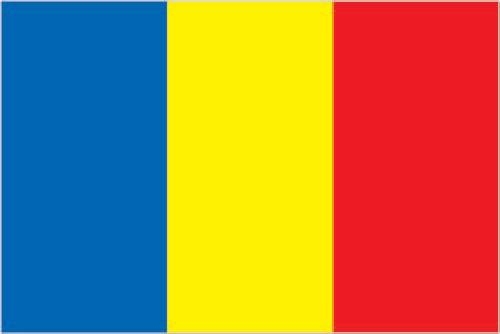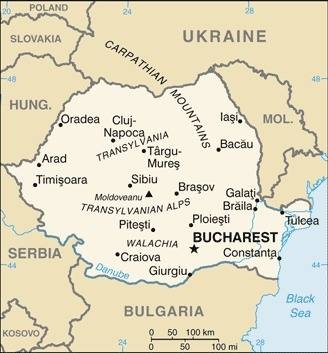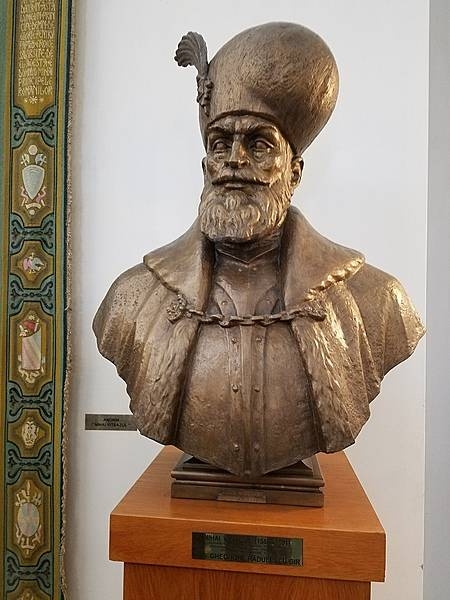104 Romania

Three equal vertical bands of cobalt blue (hoist side), chrome yellow, and vermilion red. Modeled after the flag of France, the colors are those of the principalities of Walachia (red and yellow) and Moldavia (red and blue), which united in 1862 to form Romania. The national coat of arms that used to be centered in the yellow band has been removed.
Flag courtesy of the CIA World Factbook

Map courtesy of the CIA World Factbook

Bust of Mihai Viteazul (1558-1601), also known as Michael the Brave, in the Palace of the People. Mihai was a successful military leader, defeating the Turks on many occasions. He was Prince of Wallachia (1593–1601), and briefly Prince of Moldavia (1600) and de facto ruler of Transylvania (1599–1600). Considered one of Romania’s greatest national heroes, his short-lived unification of the three principalities is seen as a precursor to the complete unification of Romania that did not occur until the 20th century.
Photo courtesy of the CIA World Factbook
Government
According to Britannica, following the collapse of communism in 1989, a constituent assembly drafted a constitution that was approved by the Romanian parliament on November 21, 1991, and by referendum on December 8, 1991. This document established a bicameral parliament consisting of a Chamber of Deputies and a Senate. Members of both houses are elected to four-year terms from each of the country’s administrative counties under a system of proportional representation: the number of seats allotted to each county is determined by the number of votes cast within the county, and the seats are divided among political parties according to their share of the vote. The president, who serves a five-year term, is elected directly by a popular vote. As commander of Romania’s armed forces and chairman of the Supreme Defense Council, the president has the power to declare martial law or national emergencies. Laws are approved by the majority vote of the members present in each chamber. In most cases, presidential decrees must be subsequently submitted for parliamentary approval and countersigned by the prime minister, who serves as the head of government. The president nominates (but cannot remove) the prime minister, who, along with the cabinet, is responsible for implementing the domestic and foreign policy of the state.
Romania is divided into 41 județ (counties) and the city of Bucharest. The central government appoints a prefect for each county who acts as the local representative for the national government. Mayors and community councils are directly elected by citizens.
The judicial system is headed by a Supreme Court of Justice, whose members are appointed by the president for six-year terms. Other elements include county courts, local courts (whose decisions may be appealed to county courts), and military courts. In the wake of Romania’s accession to the EU in 2007, judicial reform and anticorruption measures received renewed attention. In 2010 the EU published a report critical of the country’s faltering struggle against corruption, and it expressed concern about the record of the Romanian judiciary. Romania was one of only two members of the EU whose justice system continued to be closely monitored by the organization.
Romanian Civil Aviation Authority
The Romanian Civil Aviation Authority, Romanian legal entity, with headquarters in Bucharest, Şos. Bucharest-Ploiesti no. 38-40, operates as an autonomous agency of national public interest, based on economic management and financial autonomy, carrying out its activity according to the provisions of the Air Code, government decisions and ordinances, orders of the relevant minister, decisions of the general director and other applicable specific regulations , in force.
Airspace
SkyVector – Google Maps – ADS-B Exchange
ICAO countries publish an Aeronautical Information Publication (AIP). This document is divided into three parts: General (GEN), En Route (ENR) and Aerodromes (AD). ENR 1.4 details the types of airspace classes they chose to adopt from classes A through G.
Romatsa
Drone Regulations
Advanced Air Mobility (AAM) Regulations & Policies
Bilateral agreements facilitate the reciprocal airworthiness certification of civil aeronautical products imported/exported between two signatory countries. A Bilateral Airworthiness Agreement (BAA) or Bilateral Aviation Safety Agreement (BASA) with Implementation Procedures for Airworthiness (IPA) provides for airworthiness technical cooperation between the FAA and its counterpart civil aviation authorities.
Reciprocal acceptance of aviation safety-related approvals and services with the European Union Aviation Safety Agency (EASA) and Member States of the European Union are primarily governed by the U.S. – European Union Safety Agreement.
Note: The European Union has designated that import, export, and oversight of certain ‘low risk’ civil aviation products are not covered by the EU, and will be administered by individual EU Member State aviation authorities. These products are defined in Annex 1 of REGULATION (EU) 2018/1139 (formerly known as “Annex 2 aircraft”). FAA validation/U.S. import of these products will be governed by the BASA IPA between the FAA and that EU Member State aviation authority, not the US-EU Safety Agreement.
Legacy Implementation Procedures for Airworthiness (IPA): Contact AIR-40 at 9-AWA-AVS-AIR400@faa.gov for assistance when using this legacy IPA in support of a project, and before contacting an Authority about use and effectivity of this document.
Advanced Air Mobility (AAM) News
2025
Video courtesy of Advanced Air Mobility Institute from the July 2025 Global AAM Forum.
2025
Video courtesy of Advanced Air Mobility Institute from the January 2025 Global AAM Forum. Complete session for Day 2 of this Forum is available on the Advanced Air Mobility Institute YouTube Channel
Short Essay Questions
Scenario-Based Question
You have been hired by a Drone Startup Company. Your boss has immediately assigned this job to you.
They need you to prepare a one-page memo detailing the legalities of using a drone to film in Bucharest.
They need you to mention any national laws and local ordinances.
They specifically want to know what airspace (insert pictures) you will be operating in and whether or not you need an airspace authorization.
Does it matter whether or not you are a citizen of the country?
Lastly, there is a bonus for you if, as you scroll through this chapter, you find any typos or broken links!
Short Essay Questions
- What are the drone categories?
- How is registration addressed?
- How is remote ID addressed?
- What are the model aircraft rules?
- What are the commercial drone rules?
- Are there waivers or exemptions to the rules? If so, for what?
- Would you share a link to an interactive airspace map?
- How is BVLOS addressed?
- How can you fly drones at night?
- How can you fly drones over people?
- Where do you find drone NOTAMs?
- What are the rules for drone maintenance?
- What are the rules for an SMS program?
- What are some unique rules not mentioned above?
- What are the C-UAS rules?
- What are the AAM rules?

